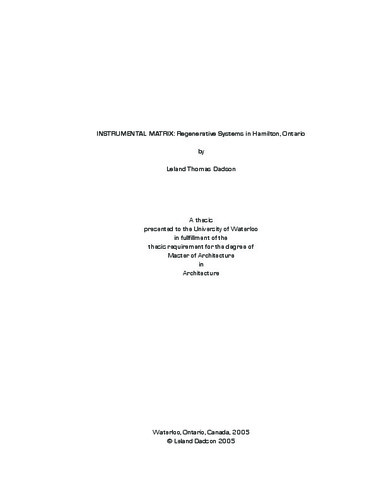| dc.description.abstract | Positioned at the metaphysical divide between civilization and wilderness, this thesis investigates the potential for symbiotic relationships among cultural, ecological and industrial systems in an effort to suggest alternative modes for human sustainability. The City of Hamilton, where steel and iron industries continue to scar the landscape, serves as the location for a speculative design intervention. Amongst existing urban structures, a hybrid form of industrial production is proposed to acknowledge society’s reliance on artificial devices. In turn, this hybrid form is integrated with natural ecological processes to demonstrate humanity’s dependence on the natural world.
The first chapter positions the thesis within a discourse regarding the boundary between civilization and wilderness and their conventional dichotomy. The thesis is aligned to themes of ecological-artificial hybridization, which include the scientific application of biological metaphors, economic and manufacturing theories of industrial ecology, and architectural and design methodology.
Chapter two employs Complex Systems methodology to structure an analysis of Hamilton’s ‘intrinsic’ and ‘extrinsic’ systems. The city is considered within ecological, historical, cultural, industrial and economic contexts, at local and regional scales.
Chapter three proposes an urban plan for Hamilton that seeks to regenerate and integrate ecological, cultural and industrial systems. Within the framework of this plan, industrial ecosystems can coexist with public function and ecological infrastructure in close proximity. Though designed for long term application, the plan is intended to provide context for a more detailed and immediate intervention within the scope of the thesis.
Chapter four proposes the implementation of a speculative urban design, as a central component of the urban plan. Sited on the Stelco pier, one of the largest and oldest steel producers in Canada, the design would reclaim a pivotal historical and physical location along the Hamilton waterfront. Regeneration of the heavily contaminated industrial site will be initiated with a phased program of remediation and managed ecological succession.
The new science of industrial ecology will inform this new development. This approach is based on a shift from ‘open loop’ systems, in which material and energy flows dissipate through processes of waste creation, towards ‘closed loop’ systems in which energy and material are recycled. A new Instrumental Matrix is proposed where decentralized cultural, ecological and industrial systems are interwoven to create diverse and sustainable habitats for wildlife, people and industry. | en |

